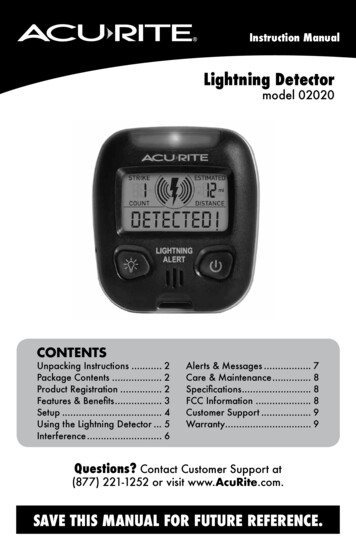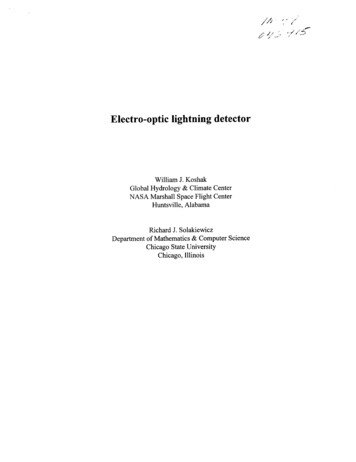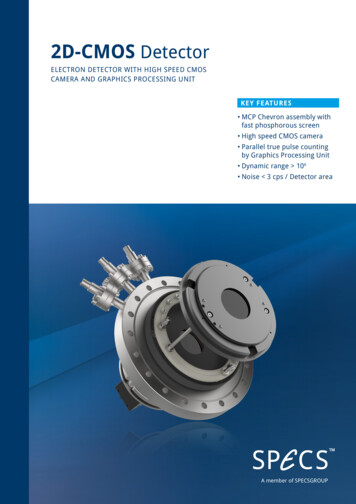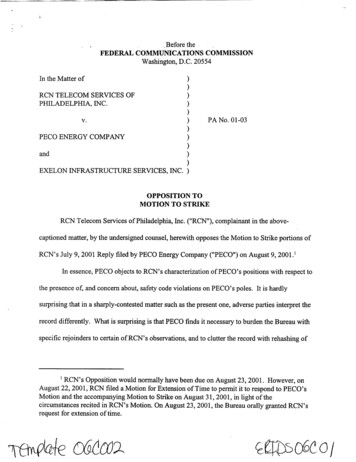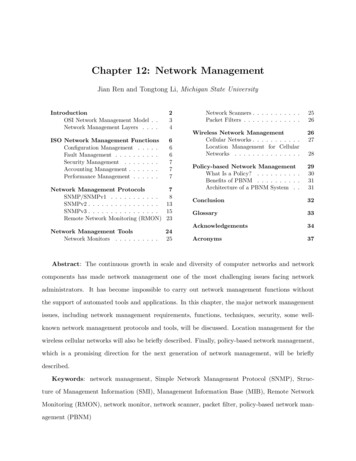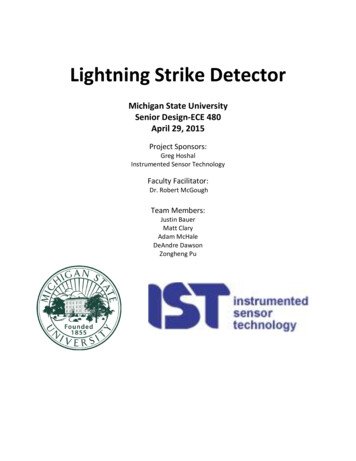
Transcription
Lightning Strike DetectorMichigan State UniversitySenior Design-ECE 480April 29, 2015Project Sponsors:Greg HoshalInstrumented Sensor TechnologyFaculty Facilitator:Dr. Robert McGoughTeam Members:Justin BauerMatt ClaryAdam McHaleDeAndre DawsonZongheng Pu
AcknowledgmentsGreg Hoshal: Special thanks to the team’s corporate sponsor Instrumented Sensor Technologyand especially Greg Hoshal. Greg Hoshal provided great insight toward project goals andexpectations. He also provided the team with valuable equipment that was used to test anddesign the Lightning Strike Detector. We appreciate the extra effort given to allow a successfulprojectDr. S. Ratnajeevan H. Hoole: Special thanks to Dr. Hoole as the team’s faculty advisor. Dr.Hoole worked with the team to perfect all reports and presentations. He also provided insighttoward the characteristics of lightning and different approaches on how to detect it. Weappreciate the opinions and expertise shown during meetings.Greg Mulder and Brian Wright: Special thanks the Greg Mulder and Brian Wright. They bothhelped the design team with using certain equipment and especially with designing the device’senclosure. They also went beyond that to offer some suggestions and opinions on how to dothings. We appreciate all the work you both did to help finish our project.Executive SummaryThe purpose of the lightning strike detector project is to develop a detection system forone of the most common issues with data loss on business computers. This data loss is due tothe electromagnetic fields and secondary currents caused by lightning strikes. The team willbuild a circuit using a series of different sensors and coils to determine when a lightninginduced magnetic field is present. Then, the team will use a microcontroller and an LCD tocount how often such surges occur.1
Table of ContentsChapter 1: Introducing the Problem 1.1 Introduction 1.2 Background 1.3 Current Designs 1.4 The ApproachChapter 2: Exploring a Solution and Selecting an Approach 2.1 Exploring the Solution 2.2 Selecting a Solution 2.3 Budget 2.4 Gantt ChartChapter 3: Technical Work Performed 3.1 Hardware 3.1.1 Sensing and Amplifier Circuit 3.1.2 One-Shot Multivibrator 3.1.3 Arduino-LCD Interface (Hardware) 3.1.4 Enclosure 3.2 Software 3.2.1 Arduino-LCD Interface (Software)Chapter 4: Test Data and Proof of Design 4.1 Test Procedures 4.2 Project Functionality 4.3 SustainabilityChapter 5: Summary, Final Costs and Future Improvements 5.1 Summary 5.2 Final Costs 5.3 Future ImprovementsAppendix 1Appendix 2Appendix 333456891011121419202730313132343540412
Chapter 1: Introducing the Problem1.1 IntroductionLightning strikes are a powerful natural phenomenon that can cause catastrophicdamage to electrical devices within the vicinity of the strike if they are not properly protected.The average lightning strike carries an average current of 30 kA and lasts only the span of 60 to200 microseconds. Most structures are protected from lightning strikes by utilizing specialgrounding systems, designed to route large amounts of electrical current to ground through asafe, controlled route. By routing the current away from the parts of structure susceptible tohigh currents the structure can be protected from any major physical damage due to lightning.At particular facilities it is beneficial to know, and keep count of, the occurrence oflightning strikes. This knowledge can be used to perform maintenance on the groundingsystems of such structures, as well as for the inspection of specific parts of the structure(computers, automated control systems, etc.). Although grounding systems provide a degree ofprotection to the structure itself, the EMP given off by the lightning strike can cause errors inany electrical systems that are operating at the time of the strike. The team's goal in this projectwas to design a lightning strike detector that can identify and record lightning strikes that occurat a particular facility, thus ensuring the maintenance of the facility can take the proper steps tofix any issues that may have been caused by the strike.1.2 BackgroundLightning is an electrostatic discharge that occurs between electrically charged regionsof a cloud and the earth. Occurring during electrical storms, lightning is due to the buildup ofelectrical charges within the cloud and on the earth below. The top of a storm cloud typicallyaccumulates a large positive charge, while the base of the cloud builds up a large negativecharge. A region of positive charge also follows the cloud on the earth below, and usually tendsto concentrate on tall objects. A lightning strike begins when a channel of negative chargesbegins to make its way to the ground. At the same time, currents of positive charges begin tomove upward from the ground. When these two charges eventually meet, it causes a largeelectric current to flow up to the cloud. Positive charges of the Earth tend to gravitate toward3
tall structures so they can be close to the negative charges of the storm cloud. As a result, manylarge buildings can be heavily damaged due to a lightning strike. In order to protect thesestructures, precautionary devices known as lightning rods are often installed to reduce thedamage of a lightning strike.A lightning rod is a metallic object mounted on top of a structure designed to provide asafe route to ground the current produced by a lightning strike. The rod protects the structurefrom any significant damage that could potentially be caused by lightning. A typical lightningstrike carries thousands of amps of current. The result of lightning striking an unprotectedstructure can cause serious damage. However, lightning rods are not 100 percent effective, asmany computer systems and electronics are still susceptible to significant damage fromlightning. This damage is due to the electromagnetic field that is produced by the strike, as wellas secondary currents that can be induced in electrical wiring. The damage could potentiallycause a variety of errors in any computer or electrical systems that are running during the timeof the strike. Because of this, it is desirable to know when lightning has struck a certainstructure. This allows one to check any computer systems or electronics to see if any errorsoccurred during that time.1.3 Current DesignsCurrently, a variety of lightning strike detectors exist on the market for bothprofessional and personal use. Most of these detectors are based around circuitry designed topick up the RF electromagnetic signal produced by the lightning strike. However, this alone isnot a very effective tactic in detecting lightning, as RF signals from outside sources can triggerfalse alarms. Due to this, some lightning strike detectors use electromagnetic field detection incombination with circuitry designed to detect the light pulse given out by lightning. Since fewsources other than lightning produce both a light pulse as well as an electromagnetic pulse, thismethod has been found to be effective in detecting a lightning strike. These circuits are oftendesigned to detect lightning from a distance. Because of this, most of these devices are not wellsuited to this project, as the goal is to detect only when lightning strikes a certain building orstructure.4
In order to design a device to better suit to meet the goals outlined by the customer theteam has made a variety of changes to the devices already on the market. As mentionedbefore, most lightning strike detectors use the EMP radiated from lightning when a strikeoccurs. EMP energy can be transferred in a variety of forms, including electric fields, magneticfields, electromagnetic radiation, and electrical conduction. This presents a few differentproblems in designing the final product. First, while energy transmitted through electrical fields,magnetic fields, and electrical conduction act only over relatively short distances,electromagnetic radiation acts over a long range. This means lightning that occurs far awayfrom user’s location can trigger the device. The second issue with this method of detection isthat it is very susceptible to outside interference from anything that radiates energy in any ofthe forms mentioned above can trigger the device in addition to lightning.1.4 The ApproachTo address these issues the team sought a different way to detect a lightning strikewithin a very limited range. The solution chosen by the team was to design a device to detectthe magnetic field radiated from the grounding rod of a building as it is struck by lightning.Because lightning can produce anywhere from 5-100 kA of current, the magnetic field radiatedfrom a grounding rod as it is struck by lightning is very strong, as well as brief. By shielding thedevice from the other components of the EMP given off by lightning and isolating the magneticfield, any outside interference could be greatly reduced. Due to the rate at which the magneticfield dissipates through air the device can also be limited to detecting a strike within a few feetof a desired location while ignoring strikes that occur at further distances away. This aspect ofthe design was very important to the team because it separated what the team wanted to dofrom designs that are currently on the market.5
Chapter 2: Exploring a Solution and Selecting an Approach2.1 Exploring the SolutionFigure 1: FAST DiagramThe Lightning Strike Detector project has several different functions involved whichrequire different subsystems. These subsystems can be seen in the FAST diagram shown infigure 1. The main functions are to detect a lightning strike, record the time of a lightning strike,count the amount of lightning strikes, and withstand the weather and to perform over a longperiod of time. Each of these main functions required specific detail so that they could beimplemented smoothly within the design.The main function of the Lightning Strike Detector is the ability to detect a lightningstrike. Lightning has many characteristics that can be sensed with different circuit elements.Some of these characteristics include electrostatic discharge and magnetic field due to currentflowing through a grounding rod. Sensing electrostatic discharge would require the device tohave an antenna. This antenna would act as the sensing circuit element for the device. Sensinga magnetic field could be done with a variety of different sensors. Sensors such as magneto6
resistors, inductors and Hall Effect sensors could be used. The main issue to focus on in thissubsystem is to ensure that only the lightning strike is being sensed by the device. Externalnoise, such as radio waves or cell phone signals, could cause the device to misfire and detect afalse strike.Another important function of the Lightning Strike Detector is the ability to record thetime of the lightning strike. Time in this definition is the exact date on which the strike occurredalong with the exact time of day. In order to do this a precise clock and calendar would need tobe used. The clock would have to run all the time to ensure that the time was accurate. Anotherissue with this function would be recording the time a strike occurred on a microcontroller andthen displaying it on a screen. This would require a microcontroller to be able to communicatewith both the clock and the screen at the same time.The next function would be the ability to count several different lightning strikes. Thereis a possibility that the building this device is on can be struck more than once in a month oryear. This requires the Lightning Strike Detector to be able to count and record many strikes. Inorder to record many strikes a microcontroller must be programmed to hold an array ofmemory. This array will allow the user to be able to locate all of the recorded memory. To makethe device more user friendly there will be a scroll feature that will allow the user to see all ofthe recorded memory on a display screen.Another important function of the device is the ability to withstand the weatherelements. This includes temperature, precipitation and lightning. The materials chosen for theenclosure are very important to this subsystem. The material must be waterproof, but alsoshould have the ability to shield the circuitry from the electrostatic discharge of lightning. Afaraday cage could be used to protect the circuitry from lightning strikes. A faraday cageconsists of a conductive material that completely surrounds the circuit and is also grounded.Finally, the Lightning Strike Detector should be long-lasting. Long-lasting in this casemeans operating in the field for six months without having to change the battery. One way tohelp achieve this goal would be to use passive sensing elements. Passive elements would beideal in the fact that they would not require additional power to operate them.7
2.2 Selecting a SolutionInitially the design team had proposed four different design solutions. These designsolutions included a magnetic field detector using an inductor, a magnetic field detector using aHall Effect sensor, the implementation of reed switches and an electrostatic discharge detector.In order to select a solution from this list the design team constructed a selection matrix. Thisselection matrix is shown in table 1 and includes the design specifications, the importance ofeach specification, the different possible solutions and how these solutions compared to eachdesign specification. To decide which design was ranked the highest the team multiplied theimportance rating of each design specification with the ranking each design had for that designspecification. Then each multiplied value was added up and totaled. The design with the highestvalue in the total row was then ranked the best.After several weeks of testing the various proposed circuit designs, the design teamdecided to go with the magnetic field detection approach. This decision was made due to thefact that the magnetic field detector ranked
The main function of the Lightning Strike Detector is the ability to detect a lightning strike. Lightning has many characteristics that can be sensed with different circuit elements. Some of these characteristics include electrostatic discharge and magnetic field due to current flowing through a grounding rod. Sensing electrostatic discharge would require the device to
